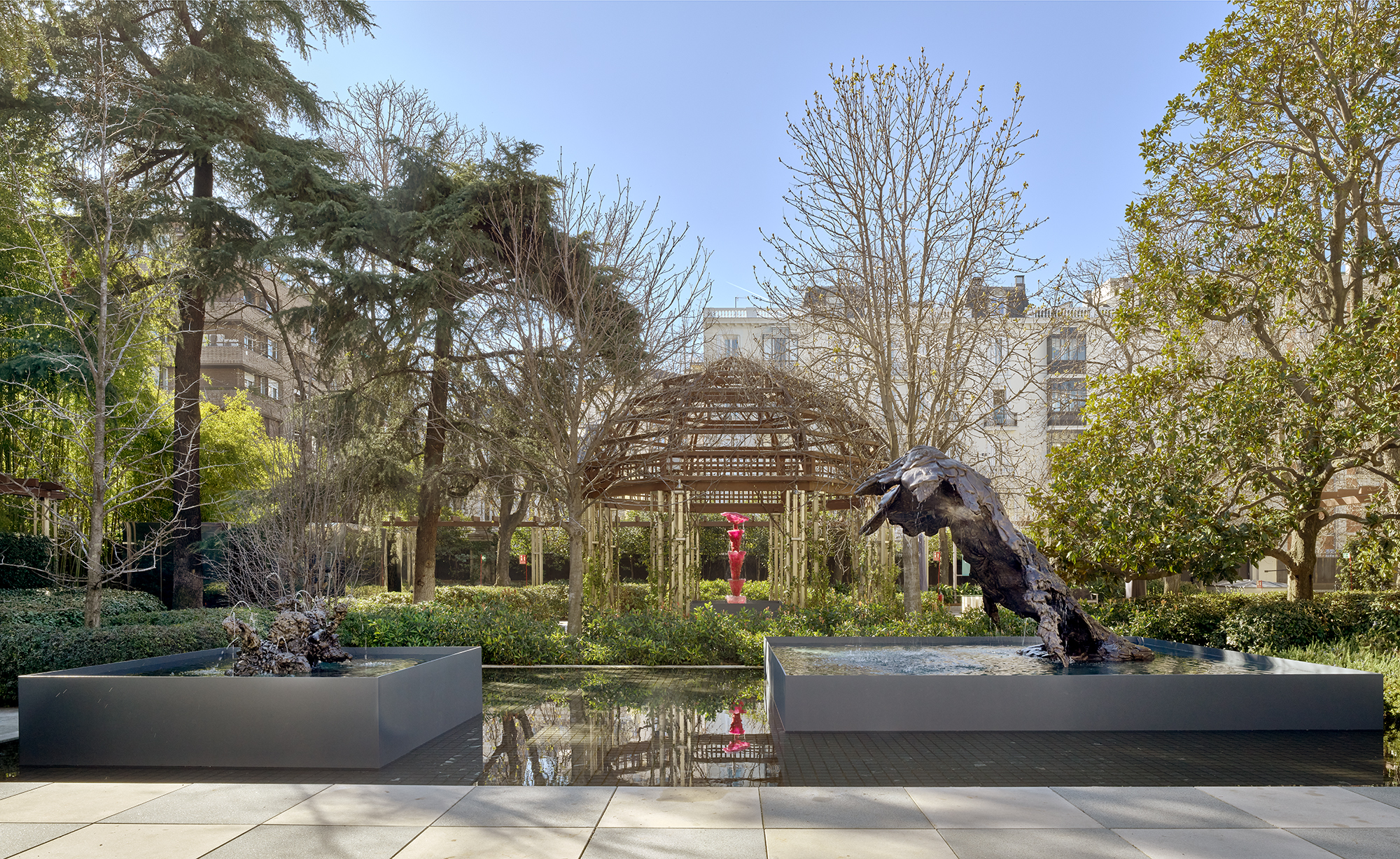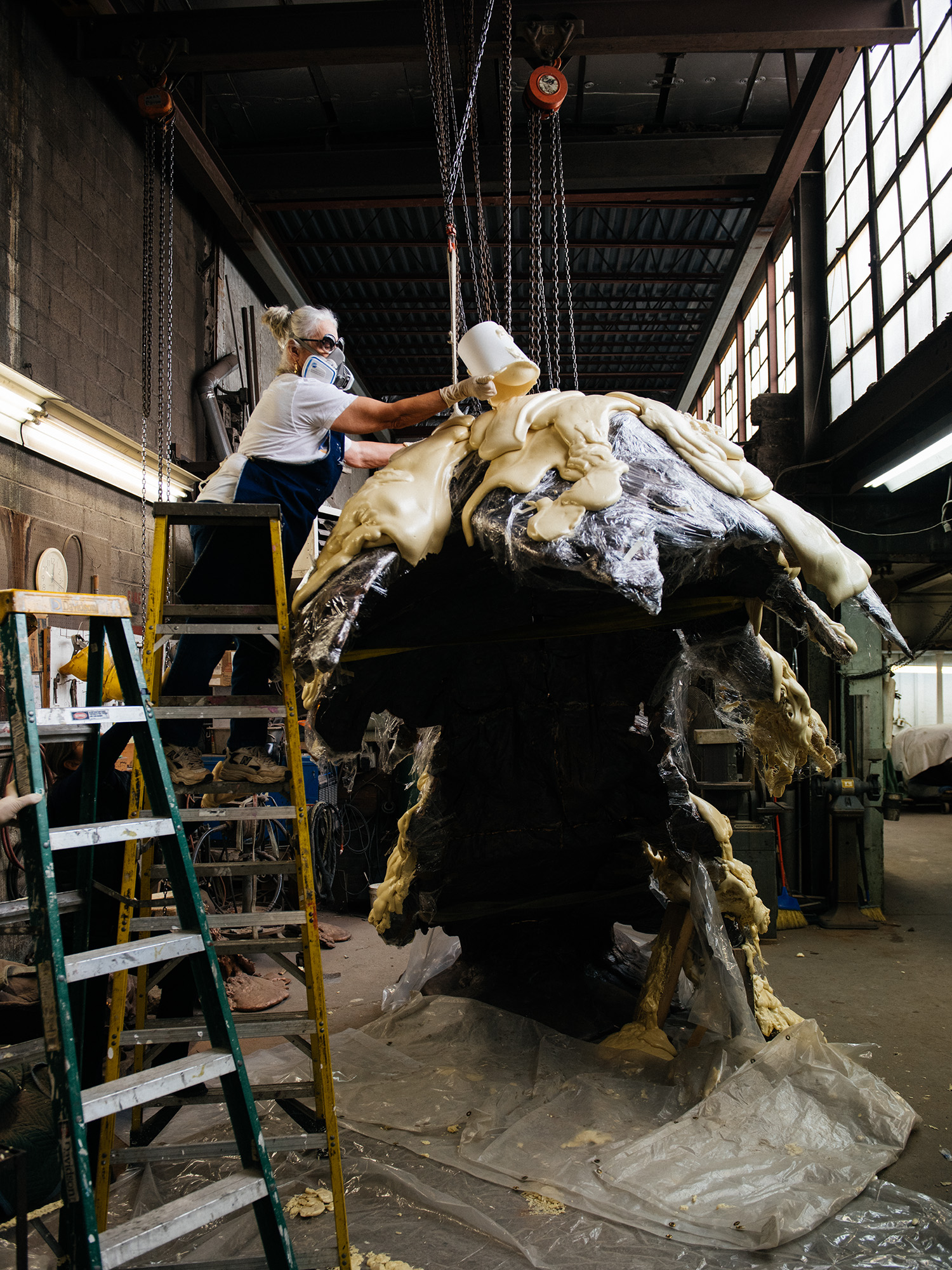Lynda Benglis’ fountains are erupting in Madrid
The small, private Madrid garden of Banca March is turned into
a temporary space of watery eruption with the temporary display of four
fountains by American artist Lynda Benglis. From teetering towers to small
bubbling eruptions, Benglis’ sculptures speak to the surrounding nature.
A private garden in the centre of Madrid is open to the
public to enjoy for a rare experience, with the space animated by four large
fountains designed by American artist Lynda Benglis. For the first time in
Spain, Banca March are exhibiting works by an artist that in 1970 Life magazine declared was the heir to Jackson Pollock.
Then, the artist was working in ways which spoke to Pollock’s splaying of paint over a canvas, making a series of “pours” in which she made Pollock’s process 3D, tipping brightly coloured latex directly onto the floor and turning the material into lava-flow-like sculptural forms. Her practice evolved, but always kept at its heart this primordial sense of eruption, flow, burst, and flood.
![]()
![]()
The square, concealed garden is at the heart of the bank’s HQ in central Madrid, in the shadow of the José Luis Picardo Castellón-designed banded marble and glass Fundación Juan March, founded in 1955. The bank is opening their private garden to the public for two days a week, one of a range of planned events leading to the bank’s 2026 centenary. There are four Benglis works installed, though their scale meant it was no mean feat to transport and install the works – the largest, Bounty, Amber Waves and Fruited Plane (2021) are three slender towers nearing eight metres in height.
They are also formed of a pouring method, the artist creating a series of interlocking sections of cast bronze, with a black patina. Water springs from their summits, cascading down into a vast purpose-built pool at the base, the spilling water seemingly mimicking the texture of the sculpture itself.
![]()
![]()
Within a sheltered and planted pavilion sits another work, Pink Lady (for Asha) (2013), with a similar poured aesthetic but here made of polyurethane in a striking pink. Benglis has previously spoken about the holes and piles crabs make on the beach as they extract and displace mud, here carrying an essence of that texture from nature into an uncanny, unnatural bright plastic – a colour inspired by the festival kites of Ahmedabad.
The third work within Banca March’s gardens – also home to a permanent Cristina Iglesias walk-through sculpture (see 00047) which speaks to Benglis’ work in many ways – is Crescendo (1983-1984/2014-2015), a work thought to have been lost before its rediscovery and reimagination by the artist three decades after its creation. It was originally created for the 1984 Louisiana World Exposition held in New Orleans, held alongside the Mississippi and with the theme of “The World of Rivers—Fresh Waters as a Source of Life.” After the end the event, the work disappeared until it turned up in storage at a waste water treatment centre in the city of Kenner, 20 kms from the fair site.
![]()
![]()
![]()
![]()
Then, the artist was working in ways which spoke to Pollock’s splaying of paint over a canvas, making a series of “pours” in which she made Pollock’s process 3D, tipping brightly coloured latex directly onto the floor and turning the material into lava-flow-like sculptural forms. Her practice evolved, but always kept at its heart this primordial sense of eruption, flow, burst, and flood.


figs.i,ii
The square, concealed garden is at the heart of the bank’s HQ in central Madrid, in the shadow of the José Luis Picardo Castellón-designed banded marble and glass Fundación Juan March, founded in 1955. The bank is opening their private garden to the public for two days a week, one of a range of planned events leading to the bank’s 2026 centenary. There are four Benglis works installed, though their scale meant it was no mean feat to transport and install the works – the largest, Bounty, Amber Waves and Fruited Plane (2021) are three slender towers nearing eight metres in height.
They are also formed of a pouring method, the artist creating a series of interlocking sections of cast bronze, with a black patina. Water springs from their summits, cascading down into a vast purpose-built pool at the base, the spilling water seemingly mimicking the texture of the sculpture itself.


figs.iii,iv
Within a sheltered and planted pavilion sits another work, Pink Lady (for Asha) (2013), with a similar poured aesthetic but here made of polyurethane in a striking pink. Benglis has previously spoken about the holes and piles crabs make on the beach as they extract and displace mud, here carrying an essence of that texture from nature into an uncanny, unnatural bright plastic – a colour inspired by the festival kites of Ahmedabad.
The third work within Banca March’s gardens – also home to a permanent Cristina Iglesias walk-through sculpture (see 00047) which speaks to Benglis’ work in many ways – is Crescendo (1983-1984/2014-2015), a work thought to have been lost before its rediscovery and reimagination by the artist three decades after its creation. It was originally created for the 1984 Louisiana World Exposition held in New Orleans, held alongside the Mississippi and with the theme of “The World of Rivers—Fresh Waters as a Source of Life.” After the end the event, the work disappeared until it turned up in storage at a waste water treatment centre in the city of Kenner, 20 kms from the fair site.


figs.v,vi
Benglis set about not just renovating the work, but building
onto it and modifying it the work now displayed in Madrid, akin to a collapsing
wave frozen in mid air, its shaded cavity appearing as if it might come
crashing down on the nearby fourth work, Knight Mer (2007-2022), the smallest
displayed work, appearing as a bubbling rupture in the still pool.
On their way to Madrid, the three bronze works in this collection stopped off in Paris to form the centrepiece of the Loewe Spring/Summer 2024 menswear show for the city’s fashion week, the water cascading to pools within the catwalk as models navigated around. For Loewe, the works were indoors, but here in the tranquillity of Banca March’s Madrid garden, the works take on an entirely different aura, their naturalistic forms and trickling, glistening water speaking poetically to the trees and landscape setting.
On their way to Madrid, the three bronze works in this collection stopped off in Paris to form the centrepiece of the Loewe Spring/Summer 2024 menswear show for the city’s fashion week, the water cascading to pools within the catwalk as models navigated around. For Loewe, the works were indoors, but here in the tranquillity of Banca March’s Madrid garden, the works take on an entirely different aura, their naturalistic forms and trickling, glistening water speaking poetically to the trees and landscape setting.




